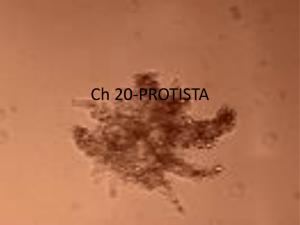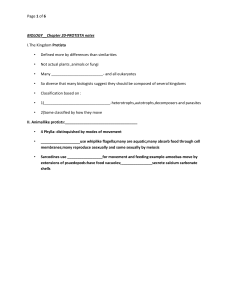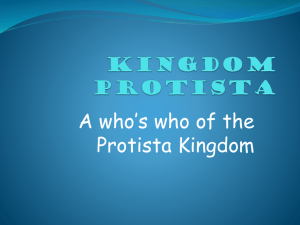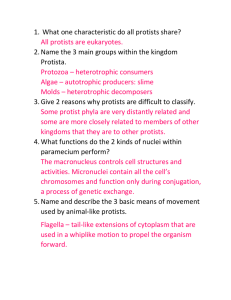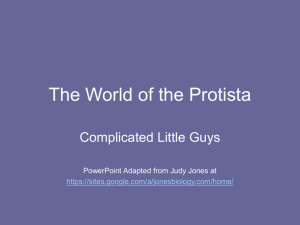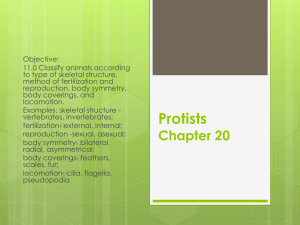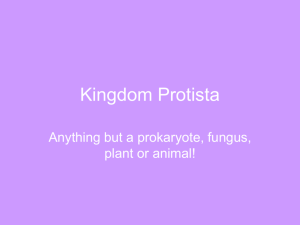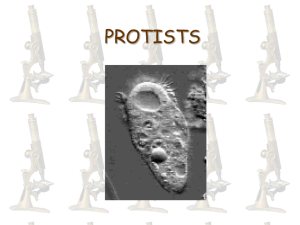PROTISTS
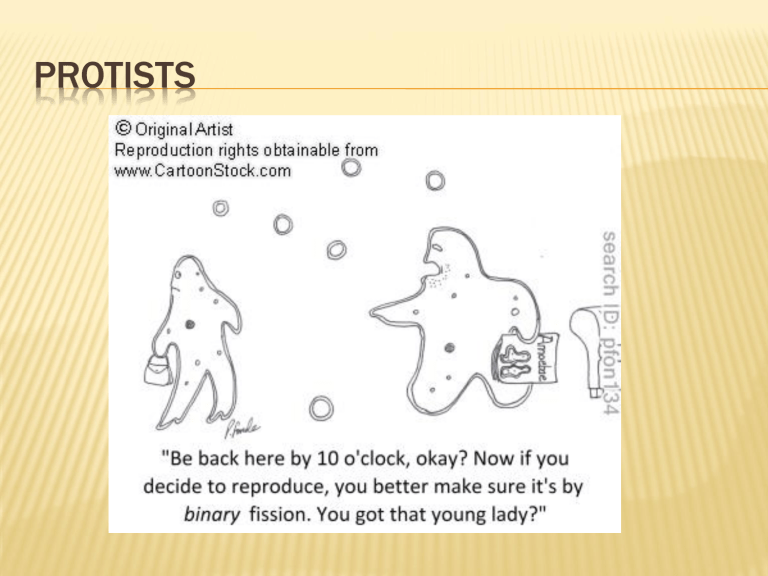
PROTISTS
THE PROTISTS
GROUP
ANIMAL-LIKE
PROTISTS
Ciliates, amoebas, apicomplexans, and zooflagellates
PLANTLIKE
PROTISTS
Euglenoids, diatoms, dinoflagellates, algae
EXAMPLE
FUNGILIKE
PROTISTS
Slime molds, water molds, and downy mildews
DISTINGUISHING
CHARACTERISITICS
Amoeba Green Algae Slime Mold
• Considered animal-like because they consume other organisms for food
• Some are parasites
• Considered plant-like because they make their own food through photosynthesis
• Some consume other organisms or are parasites when light is unavailable
• Considered funguslike because they feed on decaying organic matter and absorb nutrients through their cell walls
• Some slime olmds consume other organisms and a few are parasitic
HABITATS
• Protists can be found typically in damp or aquatic environments.
• Such as decaying leaves, damp soil, ponds, streams, and oceans.
• Microsporidia are microscopic protozoans that cause disease in insects and some species are used as insecticides.
• Green algae lives in the hair of sloths and helps them blend in with their environment. (symbiotic relationship)
ANIMAL LIKE PROTISTS
PROTOZOANS
Group
Ciliophora
Paramecium, Stentor,
Trichodina pediculus
Sarcodina
Amoeba, Radiolarians
Apicomplexa
Plasmodium (malaria causing)
Zoomastigina
Three species causes infectious disease in humans that are often fatal
Example
Distinguishing
Chracterisitics
Paramecium
• All have numerous short, hairlike projections called cilia for movement
• Most aquatic environements, oceans, lakes, rivers and mud
• Reproduce asexually be by binary fission
Amoeba
• All use pseudopods for feeding and locomotion.
• Most found in saltwater
• Reproduce asexually
Malaria Infected Cells
• Also known as sporozoans because they produce spores at some point in their life.
• Spores are reproductive cells that form without fertilization.
• All sporozoans are parasitic
Tsetes Fly
• Also known as zooflagellates because all use a flagella for movement.
PLANTLIKE PROTISTS
ALGAE
Group
Diatoms
Chlorophyll & secondary pigment called Carotenoids
(golden yellow)
Dinoflagellates
Some have red photosynthetic pigments
Euglenoids
Share characteristics of both plants and animals
Algae
Brown, Green, Red
Example
Distinguishing
Characteristics
• Unicellular algae
• Photosynthetic autotrophs
• Convert food to oil
• Reproduce sexually and asexually
• Most unicellular & have 2 flagella
• Some are bioluminescent
• Most found in saltwater
• Some autotrophic, some heterotrophic
• Unicellular
• Most found in freshwater
• Cell wall is replaced by a pellicle, which allows them to crawl through mud
• Brown algae is massive, kelp
• Green algae is diverse with over 7000 species
• Red algae have phycobilin that allow them to absorb green, violet, & blue light that can penetrate water to a depth of 100m!
FUNGUS LIKE PROTISTS
Group
Acellular Slime Mold Cellular Slime Mold
Go through a stage in their life cycle in which the nucleus divides but no internal wall forms, resulting in a mass of cytoplasm with multiple nuclei
Spend most of their life as single amoeba-like cells with no flagella
Water Molds &
Downy Mildew
Close to a fungus, but water molds produce flagellated reproductive cells and cells walls are composed of cellulose
Example
Distinguishing
Chracteristics
• Feed on decaying matter
• Reproduce using spores
• Cell walls contain cellulose
• Creep over rich, moist soil & engulf bacteria
• Reproduce sexually and asexually
• Live in water or damp places
• Some absorb nutrients from water or soil & some from other organisims
